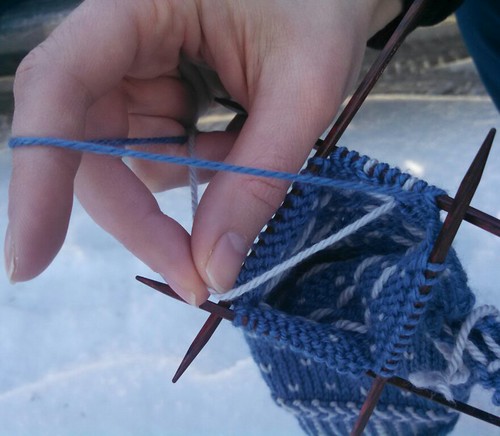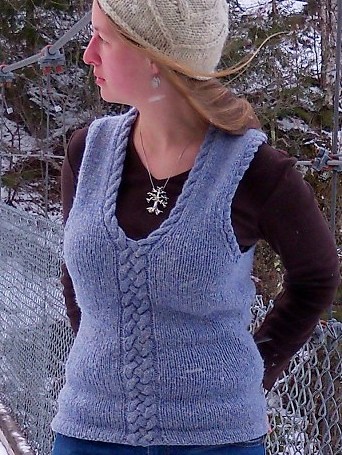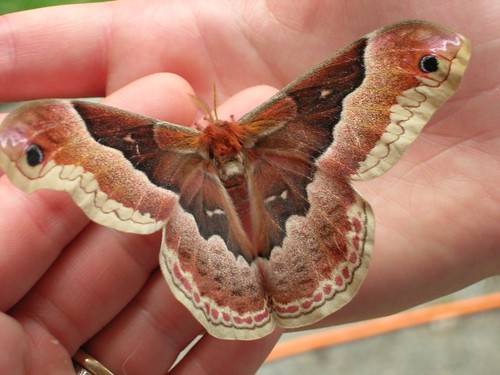One of the great things about knitting is being able to make garments that fit just right – right? Of course we all have stories of the sweater* that was 4 sizes too big. Between gauge mistakes, errata, and user error these things happen. But, assuming we can avoid (or rip out) such things a perfectly fitting garment should be possible. This is what I mean by “hidden modifications” these are the changes knitters make to a garment so it will fit them perfectly, but which an observer would never know had been changed!
I’m going to take a moment to give some tips and tricks for my La Moelle vest pattern. I have some specific tips, but you should be able to take away the more general ideas and apply them to any garment you’re working on.
All garment patterns should have a schematic**, it will be your tool to figure out what the designer intended, and how to make things better for you – personally.

A schematic might seem a little intimidating at first. But remember, the designer (me in this case) is packing all sorts of information into this for every size. You’re probably just knitting one size (or maybe 2-3, I’ll address that soon) Another thing to keep in mind is that the schematic shows the actual measurements of the GARMENT this may not be your size, in fact it probably isn’t.
Start by getting a tape measure and measuring yourself (or having a friend do it, which is probably more accurate) you’ll need bust, waist, hips – but also length from underarm to natural waist, underarm to low hips. If you want to be really accurate measure yourself at every point indicated on the schematic. Honestly, knitted fabric is pretty stretchy and I usually just go with the main points when knitting for myself, but then I’m a pretty average size. If you know you’re broad shouldered, narrow waisted, or have a long torso then you’ll know to pay more attention to these points.
In the pattern I state that this vest is good with zero, or even negative ease. That means that if you have a 36″ bust you could knit the 36.5″ size and have a little extra ease in the bust, or you could knit the 33.25″ size and have some stretch (this is a personal choice, think about how you like your other sweaters and t-shirts to fit). As you choose which size you want to knit look at suggestions from the designer, or how the garment fits the model. If you really like how an oversize A-line tunic drapes on the model in the photo – you’ll probably want to choose a size that is a few inches bigger than you.
Once you’ve decided on the best bust measurement, if you’re lucky the waist and hip measurements will line up for you as well. If so, then congratulations! Go read a book or something. If you’re not let’s continue on.
I’m going to address modifications in width/circumference first, then modifications in length. Everyone is unique, so you may need one, the other, or both.
Let’s say you’ve found a bust size that works for you with your chosen ease, and the corresponding hip size is fine, but you’re narrow waisted and need a smaller waist. You just need to add in some extra decreases, right? Well look at the schematic again, see how the hip decreases go in to a point at the waist, and then right back out again for the bust increases? I’m telling you something here: specifically there’s not a lot of “work even” rounds at the waist. So if you need to add more decreases you can’t just work an extra repeat or three of the decrease round – unless you want a garment that’s longer than the vest in the picture (which is already tunic length and comes down to the low hips) Still, it’s not a tricky change, just one that needs some advanced planning. Just start the decreases a little earlier (aka when the hip fabric measures an inch or so less than directed) If you have the opposite problem and want a less-narrow waist you can do the opposite: start the decreases a little later and work fewer of them. Either way remember to work a similar number of bust increases to get back to the correct size.
Which brings me to my next point: let’s say you need some extra fabric at the hips. Rather than doing a lot of math to figure out how many stitches to cast on, look at the other sizes on the schematic. If one of them is close to what you need you can just work more than one size. Cast on with that larger number, and start the decreases a little earlier (as I addressed above) so you can work some extra repeats of the decrease row. Once you’re down to the given number of stitches for the size you need for your waist/bust measurements you can follow those directions through the rest of the garment. See? By following two of the given sizes you can skip some extra math and still get a nicely fitting garment. If you’re trying this I HIGHLY recommend planning you knitting in advance and going through the pattern with a highlighter. That way you don’t have to try and remember that you’re knitting the size 41.25 for the hips, decreasing an extra 2 times for the waist, and then following the directions for the 36.5″ bust. Sure it makes sense now, but if you get distracted by that pretty shawl for 2 months – do you think you’ll remember come fall? I wouldn’t…
Making changes for length follows a similar logic, in the case of La Moelle it’s easier because for most of the “work even” portions I’ve given a length (in inches and centimeter) so you can work even for 2.5″ instead of 3″. If you’re working on a pattern that gives row counts instead you’ll have to treat them like stitches, but instead of doing a lot of math consider shifting up or down a size like I recommended above. As always, look at what the schematic recommends, and consider how it’ll fit your body.
For instance, if you know you’re high waisted you’ll want to knit the even portion at the hips longer than recommended, and the even portion at the bust an inch or two less to balance it out. I’ve given the hip height and bust height separately specifically so these changes can be made. If you’re petite (or just don’t like tunic length vests) you can take 1 inch off of each “work even” area for an overall shorter garment. If you know your natural waist is long, maybe you want to work even there instead of starting the increases shortly after the decreases are done. Balance this out by working less length in the hips and you’re good to go.
Overall I think the take away message is this: Measure yourself. Know your body and how you’re different from “average.” Remember that patterns are sized to averages because honestly, we designers haven’t got anything better to work with. But even (especially?) designers know that almost no one is that magical “average” number. Use the schematic as a tool to see how the vest (or other garment) is meant to fit that average number (for each size) and consider what the fit would look like in your perfect pattern – the one written just for you. Choose a size, or sizes, based on what you want, and just do a little math to transition from one to the next – rather than trying to re-do all the math and basically re-writing the pattern.
Got questions? I’ll make up some answers! I can’t (don’t have the time or inclination) re-size patterns for everyone, but I’m happy to clarify on any of these steps if I’m not making sense.
*For me it was a bamboo tank top. My gauge was off (no I didn’t check it first, why do you ask?) I was working (what I thought was) a size 36 on 24″ circular needles – so I didn’t realize how far off I was until I divided for the front/back. At which point I discovered that the half-garment on hold on scrap yarn was big enough to fit over my head and shoulders without needing to use any of the fabric on the needles. That’s right, it was TWICE my size. Luckily it knit up twice as fast the second time around.
**Note – I said “should” I’ve seen garment patterns without schematics. In fact I’ve knit some of them. And as a pathological modifier it makes me cranky every time. Hats, socks, mittens without schematics? Fine. Garments, even ones with standard construction, really should have them.





































